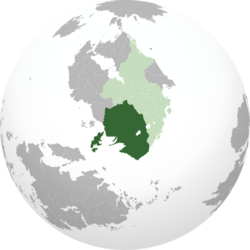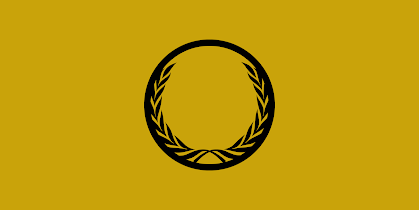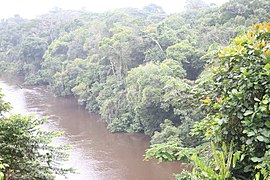Patraja
Confederated Republic of Patraja and Her Constituent Provinces Konfederationa Res-Publika Patraeje et Huene Konstitivne Provinke | |
|---|---|
Motto: Ex Nihilo Aliquid Something formed of Nothing | |
Anthem: Union Anthem of the Republic | |
 Location of XXX (dark green) In XXX (gray) | |
| Capital and largest city | Karneja |
| Official languages | Patrajan |
| Religion | Patrajan Christianity |
| Demonym(s) | Patrajan (noun) Patrajan (adjective) |
| Government | Confederative Republic |
• President of the Confederal People's Congress | Marija Torenvoa |
| Legislature | Confederal People's Congress |
| Confederal People's Assembly | |
| Confederal People's Senatorium | |
| Establishment | |
• Reorganization of The Federal Republic | March 19th, 1995 |
| Population | |
• Estimate | 38 million |
• Census | 38 million |
| GDP (PPP) | 2028 estimate |
• Total | 4,212,000 Vitaes |
| GDP (nominal) | estimate |
• Total | Your GDP = GDPPC x Population (This is calculated for you after first entry) |
• Per capita | Your GDP PC |
| Currency | Vitaes (VIT) |
| Driving side | right |
| Calling code | +981 |
Patraja, officially the Confederated Republic of Patraja and Her Constituent Provinces, is a country positioned in the south of Sarpedon, neighbored by Cartadania and Volonia, and by unoccupied land to the west. Its natural borders are mainly defined by the Pelian Channel and its offshoot minor rivers, with the river Iunctus running through the northern capital of Patraja, Karneja.
Patraja has been a member of the League of Nations since 2028, and is currently led by President Marija Torenvoa of the Confederal People's Congress. Patraja has generally been located to the far-southern portions of Sarpedon, continually occupied and resistant to various invasions until eventual full-time independence in 1883. As of the 2028 National Census, Patraja has a population of 38 million people, and a national Gross Domestic Product of 4 billion Vitaes.
Patraja is considered to have been founded as a conceptual area by the Latinic General Marcus Patrinius during an expedition to the South of the continent, wherein the general seceded from his kingdom to the north and formed his own Kingdom of Patraea. The artificially-constructed state soon fell to rampaging Slavic invasions to the nearby east, but the name had endured after the general's death in battle as the title of a local region in the area.
After the Latinic Migration to the south of the continent, the region saw continued years of local tribal battle, but the first founding of what could be considered as a similar comparative to modern-day Patraja were the Zanaeslav Agreements, or the Union of Peace, which lasted from 312 BC to 289 BC, and acted as a peace and customs agreement between many southern Slavic and Latinic tribes after decades of turmoil. In late 289, the Agreements were disrupted by continued pillaging from a secondary wave of Latinic migration. It was also during this time where many of the northernmost provinces began to be characterized as more Latin than Slavic, and where cultural tensions reached their peak in Patraja.
A second era of peace, and a formal nation, was created in 260 BC, when local tribal leader Anaeron had expertly maneuvered around his wartime opponents to gain the vast majority of deeply-Patrajan lands. The first formally-created Kingdom of Patarija lasted from 260 BC to 190 BC, and created a First Golden Age of Patraja, wherein the pagan kingdom formed most of what people consider as classical Patrajan culture. During this time, a semi-formal northern border and a rudimentary-but-rigid border control system stopped any serious migrations in and out of the nation. From this came an accidental mixing of cultures, of Slavic and Latinic, into one Patrajan nation. The Patrajan language was thought to have evolved this time, from a mixture of Astari-Slavish and Dominian-Latin - the two most prevalent language groups in the nation at the time. King Anaeron passed on his crown to his son, Maxin, in 235 BC. Maxin died an early death, and handed rule after a short interlude period of violence to his 17-year old son, Proktrii.
In 190 BC, the three-generational royal family of Patraja were overthrown by a mob after the Rape of Mariana by Proktrii. Mariana was a famed civil servant, and a rare woman of the state at the time, and was held up as a martyr of the masses as reason to abolish the current royal family. By the time of the end of the chaos, however, so many had declared themselves leader or co-king that mass confusion was abound. In particular, an old myth says that a local villager attempted to make his goat the Chancellor to the King. From 190 BC to 188-187 BC, tribal disunity essentially tore the Kingdom of Patarija into pieces.
After unrest, and several wars, many tribal leaders came together to form the Patrajan Republic of Peoples. Though not the actual name of the state, as no official name was given, the term "Patraja" first entered usage at this stage, mostly as a synonym for "The People within Patarija," whilst the actual regional name persisted to be Patarija. This union of peoples was seen as the first democratic enclave of the southern portion of the continent, and slowly expanded from 187 BC to 180 BC to envelop the whole of the formerly-royal lands, whether through negotiation or forced annexation. Notably, the term Konsal, or the anglicized Consul, entered into use in the Republic around this time, mostly referring to a figurehead-leader of a gathering of tribes. At many moments in the Republic, there were multiple Konsal's representing different tribes - and at other times, there was one that seemed to represent them all.
The Patrajan Republic of Peoples lasted until the Second Kingdom's founding in 70 BC, and is considered the official start of the formal Middle Antiquarian histories of Patraja.
Etymology
The word "Patraja" is a word that's been famously kept good track of. Whether through the bureaucratic and obscure leanings of the Patrajan culture, or by coincidental knowledge, much is known about the term. The first ancestor of the word is thought to descend from the Latinic general Marcus Patrinius, who founded the short-lived Kingdom of Patraea. Since that point, many refer to the more Slavic word of Patarija as a generally-kept local euphemism for the region in which the kingdom used to reside in. Patarija had kept regular use as the name of the local region, and then the nation, for centuries afterward, with "Patraja" first materializing in the first republican governments of the nation as a term to refer to peoples within the region of Patarija. Since that point, the two words had gradually fused together into a simple "Patraja". After Christianization and a full Latinization of the nation's etymological terms since the founding of Christianity, Patraja had seen a primary use. In 45 AC, "Patraja" was recognized as the legal name of the nation within the Third Kingdom.
History
Patraja has generally been considered a black sheep of the Sarpedonian continent, continually attempting and failing to unify into one national state. With a famed history of both republicanism and monarchism, as well as experimental forms of governance and confederacy, Patraja has had an equal mixture of eras of development and unification along with eras of chaos and invasion.
Latin Migration and The Zanaeslav Union
Patraja was originally settled as a Latin-Slavic warground after the collapse of the short-lived Kingdom of Patraea. In this melting pot of aggressive warring areas and mixing tribes, the unique Latinic-Slavic culture of Patraja first emerged in peace during the Zanaeslav Agreements, or the Union of Peace, which lasted from 312 BC to 289 BC. This tribal agreement of union and confederacy was a general peace and customs agreement and began the first sightings of a unique Patrajan culture, with an increase in migration and intermixing between the native Slavic and immigrating Latin peoples. The northern sections of Patraja in particular, though sharing a distinctly-Latin lean, were the first to unify into what was considered a true Patrajan nation. This area, perhaps in accordance to this, also partook very little in the chaos that followed after the collapse of the Agreements. Through various Latin, or perhaps Slavic, provocations unknown to historians at this time, the Agreements collapsed into tribal anarchy once more, lasting from 289 BC to 260 BC. Not much is known about the early history of the Latins and Slavs within the southern Sarpedonian continent, and even less is known about the various details leading up to the first signs of organization, but after 260 BC, more clear signs of both Patrajan culture and governance emerge.
The First Kingdom and Republic of Peoples
In 260 BC, the Patrajan tribal anarchy seemed to have come to a halt for the last time in history. A tribal chief, likely from a northern section of the region, named Anaeron, managed to gain control over the former-Union tribal lands through a mixture of bribery and war. Many attribute this seemingly-quick and absurdly-large endeavor to the man's cutthroat political strategies, though not much is known. After the conquest of most of the preliminary areas of what is considered Patraja minor today, Anaeron formed the Kingdom of Patarija, which he ruled from 260 BC until his death in 235 BC. This period of time began what is generally referred to as the First Golden Age of Patraja, where the actual culture of classical Patrajan as many know it today was formed. With a rudimentary-but-secure border preventing further Latin migrations from disorganizing local Slavic groups, King Anaeoron promoted a vast amount of cultural interludes between the populations. Many historians today consider this to be one of the earliest observations of intentional eugenic actions and laws. Indeed, at the height of the push for cultural integration in 245 BC, a new set of decrees generally referred to by historians as the Marriages of Culture Laws, King Anaeron passed orders of a minimum number of inter-cultural marriages to be reached per year. At the height of these demands, an inter-cultural marriage rate of 15% was often demanded. Many historians accuse this action, along with other strange acts of tyranny, such as the ill-funded Anaeoronic Walls, as proof of a declining mental state in the first King in his later years. King Anaeron from old age and passed on his Kingdom in the first peaceful transition of power in Patraja towards his son, Maxin.
King Maxin very much followed in his father's footsteps, continuing the First Golden Age of cultural integration and nation-building. In 230 BC, as an early act in his rule, he centralized the rule of the Kingdom by forcefully merging various bordering tribes into singular Dukjels - precursors to Late Antiquarian and Medieval duchies - to be ruled by one man instead of many. Because of this strategy, the Maxinian legal system had a much better implementation than the Anaeoronic systems, and various laws were passed. In 228 BC, shortly after the completion of the reorganization of the Kingdom, Maxin ordered the relocation of resources from the Anaeoronic Walls to the new Maxinian Walls to the north, which were completed within three years of their start. These walls were highly effective, if crude, methods of keeping out persisting Latinic migrations. King Maxin died in early death in 210 BC due to wounds sustained in battle after a regular conflict with western tribal leaders, and passed away with no apparent heir. After an interlude period of near-anarchy in the Kingdom, a nephew named Proktrii was found as an heir to Maxin.
Taking the throne at only 17 years old, Proktrii instantly showed an exhibition for being the opposite of his predecessors. Raised in a Latin home, the new king always showed a favor to the Latinic settlers of the north of the nation, and even instituted controversial amendments to the Marriages of Culture Laws that favored Latin-headed marriages. This new court culture of clear bias and a more reckless attitude also led to a reported distraction from state affairs and a new focus on the benefits to the king. The remnants of the first royal castle of Patraja, unearthed for the first time in 2022 AC, show signs of construction around the period that would confirm that Proktrii nearly quadrupled the size of his primary realm during a very short period of time. According to rare eyewitness accounts of the time, such as those in the Tablets of Warenus, a visitor from the neighboring southern islands, the court culture of King Proktrii regularly engaged in more salacious and dramatic affairs such as orgies and drama than before. Though sexual exploits were of no surprise in any court at the time, many say that the situation in the Kingdom of Patarija took an even more extreme turn. By all evidence, King Proktrii exhibited a much looser and less focused rule than his uncle, and an unclear moral code that exhibited itself for the first, and last, time in public in 190 BC.
In 190 BC, King Proktrii raped a publicly-lauded courtier and administrator today known as being called Mariana. The Rape of Mariana by Proktrii was soon shown to the public by an unknown source, leading to widespread outrage and a martyrization of Mariana by the common classes of the kingdom. Within the year, mobs had regularly gathered, and force was being used on them when it was able. At the end of 190 BC, one of these mobs successfully stormed the royal castle and killed King Proktrii. The lineage of Anaeron is thought to have ended here, though some evidence of illegitimate children involving Proktrii still remain. From the years of 190 to 188-187 BC, the nation of Patarija descended into chaos once more. As chaos increased, historical records decreased, almost to the standards of the larger anarchy of the Latin Migration period. What is known, however, is that the conflicts of this time were much more massive and exhaustive than before.
Whereas previous boons of conquest were individual tribes, the creation of a Kingdom of Patarija had shown to local leaders that an entire nation could be won, or simply claimed, through conquest. Because of this, many battles were essentially fought to the death, and the local area of the former royal family was in a course of constant contention. It had seemed that whoever held the former royal realms could declare themselves King at any time. During this 2-3 year period, some reports say that there were about a dozen self-declared Kings of Patarija, with some existing at the same time as one another. After years of exhaustive conflict, which ravaged and opened up the nation to a variety of foreign intrusions, some form an armistice was reportedly agreed upon in 188-187 BC. From here, a small confederation of tribes informally referred to as the Patrajan Republic of Peoples was formed out of mainly-northern and central areas of the nation, dead-bent on a seemingly-impossible goal of a reunion of the Patrajan people. Whether this Republic of Peoples was a confederation of pragmatic manipulation by a few important leaders, or a genuinely-idealistic national union, is unknown. However, most historians tentatively describe this as the first era of democracy within Patraja.
From 188-187 BC to 180 BC, this Republic took up essentially all of the former-Patarijan lands belonging to the Kingdom. The most notable battle, often referred to as the turning point of Patrajans as a people, was ironically held against a massive and unknown group of western invaders, famous at the time for a wish to expand fully into the devastated Patrajan areas.
The Second and Third Kingdoms, Christianization, and Invasion
What were your country's first major moves on an international level?
Fourth era
Did your country ever have a period of significant decline or internal struggle?
Fifth era
Was your country subject to imperialism later in its life, or was it an imperial power?
Sixth era
How did the 20th century affect your country?
Geography
-
First lovely location
-
Second lovely location
-
Third lovely location
-
Fourth lovely location
-
Fifth lovely location
-
Sixth lovely location
What is the general explanation of how your country exists within the world?
Climate and environment
Is your country hot or cold?
Government and Politics
How is your country ruled or governed?
Executive
Who is responsible for making high level choices in your country? Does it have a President or King?
Legislative
Who decides the laws for your country? Is there political parties and a legislature?
Federal subdivisions
How is your country divided? Are there states or provinces, or is the country directly governed from the capital as a unitary state?
Politics
What political factions exist? Who has ruled predominantly?
Law
What kind of laws and legal system does your country employ?
Demographics
What kind of people live in your country?
Ethnicity
What ethnic groups make up your country?
Language
What language or languages do your country's people use? Are there any previously used languages no longer common? Are these languages native to your country or shared with another?
Religion
Religious affiliations in the XXX (20XX)
What do your country's people believe in religiously, if anything? How many groups are there?
Education
How many people in your country are educated?
Culture and Society
What do your people do, and what are they like?
Education
What is your country's education system like? How do the schools work? What do people think about education?
Attitudes and worldview
How do your country's people view life?
Kinship and family
How are families or kinship groups structured in your country?
Cuisine
What do your people eat?
Religion
What do your people believe? Rather than demographics, as above, think about how important religion is to your people and their view about their own and other religions. What is the relationship between the prevailing view and minority religious groups? Is it an official religion, and do any laws exist about free worship?
Arts and Literature
What type of art do your people make? Do they have a tradition of painted art, well-crafted television shows, or great music?
Sports
Does your country have any major sports leagues? What types of sports are played, both professionally and for fun by your country's people?"
Symbols
Are there any prominent symbols which are well known to represent your country?
Economy and Infrastructure
How does your country's economy work?
Industries and Sectors
What are the largest parts of your economy in terms of what they do?
Currency
What exchange systems are used within your country's economy?
Healthcare
How do people in your country procure medical care? How is it paid for?
Labor
How is labor organized within your country? Are there any social institutions or unions which deal with labor concerns?
Transportation
How do people in your country get around? Is there a major highway system as well as sea- and airports?
Energy
What type of energy keeps your nation going? Are you renewable or use fossil fuels, and if you are renewable, how recently did your country transition?
Technology
How advanced is your country? Is it an innovator, or does it largely import new developments?
Military
How large is your country's military? Is it large but poorly equipped or small and elite? Does your country have a martial tradition?







